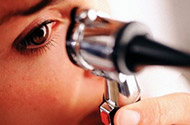Diabetic Retinopathy
Environment deterioration, changes in nutritious ratio and increase in the number of stress situations promote even higher prevalence of sugar diabetes. Unfortunately this incurable disease affects all organs and systems of a human organism, including the eyes. Every year ophthalmologists reveal more and more patients with specific diabetic eye lesions. Different manifestations are possible: diabetic cataract, diabetic glaucoma, diabetic retinopathy. Diabetic retinal damage retinopathy is the most frequent cause of complete disability.
The starting point in the development of diabetic retinopathy is lack of insulin which launches the cascade of irreversible biochemical reactions in the organism. It results in the disorder of permeability of the cellular wall which leads to intercellular edema of the retinal tissue with considerable impairment of the visual functions. Microstrokes of separate zones on the fundus of the eye appear in the process of increasing symptoms. The organism makes attempts to prevent these changes and starts growing new vessels on the damaged sites, however they are very fragile. Gradually these newly formed vessels are the reason of point or wide-spread hemorrhages. The effused blood is not dissolved completely even by medicinal preparations, the residues of blood lead to degeneration of tissues of the eye, scarring, ruptures and detachment of retina. The abovementioned changes result in blindness.
Sugar diabetes is an incurable disease; medicine can only temporarily suspend it. A doctor and a patient play a game, the prize of which is time of relative well-being.
There are three relative temporary and clinical stages of the eye lesion. The start of diabetes is characterized by insignificant vascular changes on the fundus of the eye. This stage is called diabetic angiopathy; it requires systematic observations instead of specific treatment.
After the stage of angiopathy there is the stage of preproliferative diabetic retinopathy, when irreversible changes begin. The ophthalmologist detects them while examining the fundus of the eye. At this stage the majority of patients note insignificant vision impairment with no specific or serious complaints. Unfortunately, in this period a patient is often incapable of adequate evaluation of his disease. However, efficient treatment, often avoided by the patients, is possible at the very stage of preproliferative changes.
A new era in the treatment of diabetic retinopathy was opened by an adequate novel laser coagulation of the retina. It was proven that timely laser coagulation of the retina brings about a 50% decrease in the risk of the development of diabetic retinopathy at severe stages. It should be noted that in the majority of cases the coagulation of the retina does not improve vision, it stabilizes it and prevents further development of retinopathy.
A world-renowned gold standard is preventive laser coagulation of the retina (see Our Services) and systematic introduction of vitamin and vascular preparations (via injections under the eyes, intramuscular injections and pills). The doctor's task is to collaborate with the patient for the most long-term possible maintenance of these changes without their passing to the next stage of damage.
The last stage of eye damage due to diabetes is proliferative diabetic retinopathy. A great number of new inadequate vessels are developed on the surface of the retina along with the inflammatory edema and extensive hemorrhages. There is a launch of scarring of eye tissue and detachment of the retina blindness. At this stage of disease the chances of restoring vision are minimal. Still, there are some.
Antiproliferative agents preparations, "cleaning" the retina, are introduced endovitreally (see Our Services) to stop the growth of newly formed fragile vessels. For some indications it is possible to perform vitreoretinal surgery with complete removal of transformed tissues. Unfortunately, the guarantees of improving vision are minimal at this stage.
Please, note! The most physiological method of treatment is a diet.
The aim of the drug treatment is to prescribe antiglaucoma drops, decreasing intraocular pressure. The drops should be applied on a regimented schedule without any interruptions. There are several pharmacological groups of preparations which allow taking into consideration individual specificities and degree of pathology to achieve good effect.
Unfortunately, it is not always possible to decrease pressure to required values. In such cases it is necessary to perform laser or surgical treatment.
Laser method is directed to restoration or improvement of the drainage flow, the effect of this procedure lasts for one or two years. Unfortunately, it is not always possible to stop taking drops. The advantages of this treatment are intervention without violating the integrity of the eyebulb, painless ambulatory procedure, lasting about 1020 minutes.
When the aim is complete independence from any drugs and long-term efficiency (710 years), surgical treatment is performed.
The most modern and promising method of glaucoma treatment is the implantation of a microstunt into the drainage system of the eye. It is a hollow tube of about 2 mm length, which creates free outflow of excessive fluid. This is the least traumatic surgery, the rehabilitation period is about one or two days, cosmetic defects are completely absent, the procedure ensures great long-term results.
Wide recognition has also been achieved by filtration surgeries (invasive and non-invasive) which stimulate the existing ways of intraocular fluid outflow or create new ones. The surgeries are not expensive, less traumatic, painless, and performed using modern equipment.










